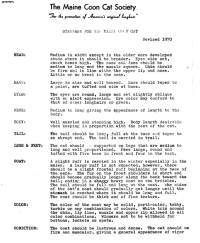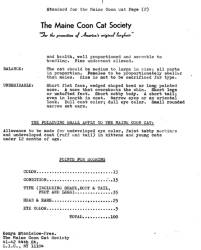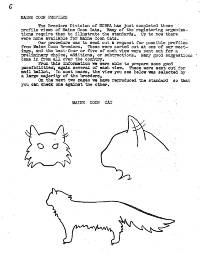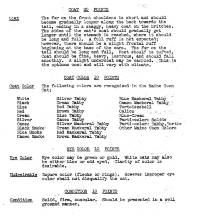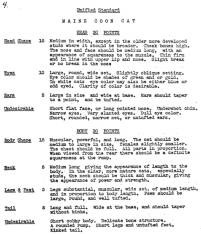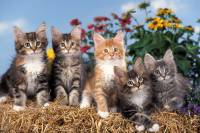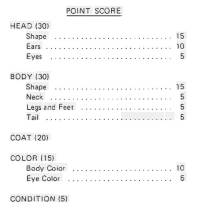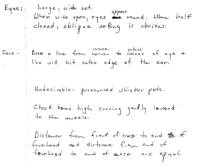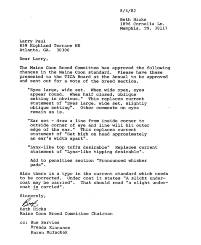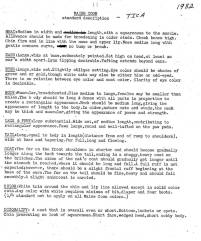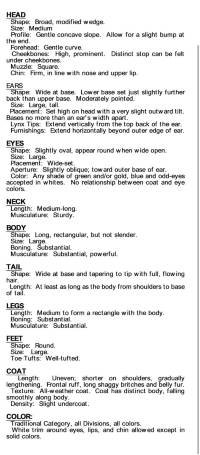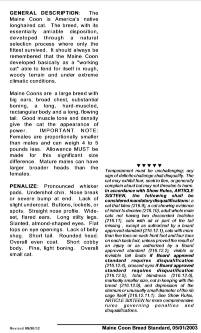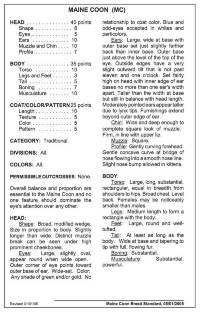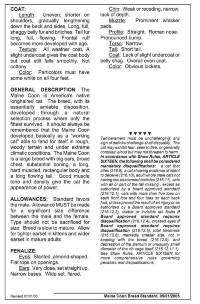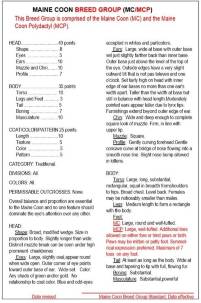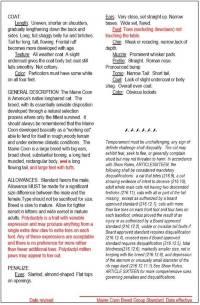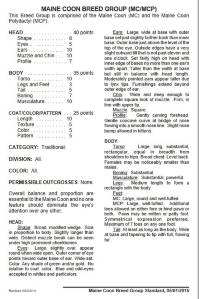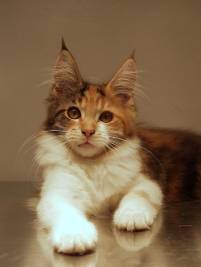The Maine Coon Standards in the Course of History
researched and compiled by Rianna Vande Vusse, abridged by Henning Mueller-Rech
Let’s take a look at something pretty important, something that will keep one busy all the time as a breeder: the different standards of our breed and theway they developed. This might be a lengthy and possibly a less then inspiring chapter. But the respective standards of the breeding association that a breeder has chosen, one has to consider and apply all the time in which one breed a Maine Coon. Standards are not only a guideline for judges at cat shows, but above all for the individual breeder. Therefore now a chapter about the most important standards: the ones of CFA, FIFè, TICA and WCF. We are working on adding the other associations standards and their history as well.
1 . The "pre" Standard
As we have read and seen in the history of the Maine Coon, the first standard for our breed as we know it was written in 1956 by Dr Rachel Salisbury. She said: "It strikes me that several points about a coon cat which are currently unacceptable to the Fancy are distinc-tive features of the Maine cat . . . such as type of body and face, irregularity of eye color, the prevalence of white trim . . .”
This standard was printed on the show flyers of the CMCCC so that exhibitors and spectators knew how to evaluate the breed. This is of course far away from Weir's general longhair standard - but at least as far away from those used today in CFA, FIFe, TICA, WCF and the other federations. It is really worth mentioning that she also mentions short-haired animals and stumpy tails in addition to the polys. Actually we think that she is anticipating the standard of the PixieBob - years before it comes into being. Somewhere on the way in the next ten/fifteen years at least the tails and hair of the Maine Coon both will be only "long" as we see it in the breed today. By the way, she has always set her standard against the one of the Persians - a reminder of Weir's standard - longer, bigger, more flowing tail. What will remain of their standard is this reference. When it says "large ears" in standards later, it means "larger than the ears of a Persian" - larger than Persian cat ears.
It distributes the points with which it is judged - and you needed at least 85 of them for a "winner ribbon" - as follows:
POINT SYSTEM OF JUDGING:
Points:
10 Head (shape of skull, face, cheeks, chin)
5 Ears (shape, size)
10 Eyes (Color, shape)
5 Tail (length, shape)
15 Body (bone structure, shape, proportions)
10 Legs and Feet (length, shape)
20 Coat (color, markings, luster)
15 Health (body balance, coat texture and condition, facial expression general resilience)
10 Condition (grooming, evidence of care)
This is actually a very interesting distribution of points, the weighting of which could certainly be argued about, if it would have had any influence on the standards we are accustomed to, but especially the 15 points for health we find highly interesting and would wish that these could somehow also be found in today's evaluation rules. Nothing similar to Dr Salisbury's scoring, however, will be seen in future Maine Coon standards. The points that come closest to being awarded "Health Points" are the points that are awarded for "Condition", which is the state of care. However, this standard and the CMCCC are disappearing in the face of history and we just dug that up to show that there was something.
2. The first "real" standards emerge
"The process of looking at a cat as it exists, projecting how it would look if it were “perfect”, then putting these ideas into words is incredibly difficult." –Sonya Stanislow, 1985
After the Central Maine Cat Club disbanded in 1963, several groups of enthusiasts continued attempts to revive the breed. Knowing that a "correct" breed standard was necessary to have the cats judged at shows, three of these groups created their own standard without respecting the Salisbury standard.
The first was the standard of the Independent Cat Federation (IFC). The ICF standard, published in the 1969 Spring Issue of the "Scratch Sheet" - which is also not very well readable in the MCBFA digital archive thanks to the quality of the original - is the first standard with clear descriptions of what the cat should look like and a "modern" point distribution that we know of:
ICF MAINE COON STANDARD
HEAD: The head is carried high, is medium in width (except in the older more developed studs where it should be quite broad). Eyes wide set and cheek bones high. The nose and face should be medium to long and the muzzle square. The face should be smooth up to the base of the ears, with a ruff around and from behind the ears, from the rear of the cheek down under the jaws and flowing out from the chest. Chin should be firm and in line with the upper lip and nose. A perpendicular look. Slight or no break in the nose
.EARS: Large in size and well housed. The ears should taper to a point and be wide set, tufted and not too wide at the base.
EYES: The eyes are round, large and slightly oblique: alert looking. Any brilliant eye color allowed.
NECK: Medium to long giving the appearance of length to the body. In the old more mature cats, the neck should be thick and muscular.
BODY: Well-muscled and standing high. The body should be long and the chest should be full and medium to large in size.
TAIL: The tail should be long, full at the base and taper to an abrupt end. The tail is carried in trail. No kinks.
LEGS AND FEET: The cat should be supported on legs that are medium to long and well proportioned. The back should be level but in stance the hind legs hold the body slightly lower than the front. The feet should be round and tufted with five toes in front and four in the back.
COAT: A slight ruff is carried in the winter especially in the males. The fur on the front shoulders is short and should become gradually longer along the back toward the tail ending in a shaggy, heavy coat on the britches. The tail should be full and long in coat. The side of the cat’s coat should gradually get longer until the stomach is reached where it should be long and full. The texture of the coat should be fine and very heavy.
COLOR: The color of the coat may be solid, particolor, tabby or any combination of colors. White trim around the chin, lip line, muzzle and upper lip allowed in all color combinations.
CONDITION: The coat should be lustrous and dense. The cat should be hard and muscular, giving a general appearance of vigor and health: be well-proportioned and amenable to handling. Fine undercoat allowed.
UNDESIRABLE: Short flat face, wedge shaped head or long pointed nose. A nose that overshoots the chin. Short legs and untufted feet. Short, cobby body. A short tail. Even length in coat. Narrow eyes or an oriental look. Dull coat color. Dull eye color. Small round ears.
POINTS FOR SCORING: Color (5), Coat (15), Condition (15), Type – including shape, body and tail, feet and legs (35), Head & Ears (25), Eye color (5) TOTAL – 100
The peculiarities here are clear to see: the ears "should taper to a point and be wide set, tufted and not too wide at the base". This will be the first thing that will change in the future.and also the polys are not mentioned here, signs of war between the pro- and contra-fraction of the early breeders: "The feet should be round and tufted with five toes in front and four in the back." It seems to me that the New Yorker Sonja Stanislow, who is responsible for much of this standard, didn't like these feet. It is also evident that the distribution of points does not correspond in the slightest to that of the 1956 standard. Very interesting and important is that foundatio animals are accepted here, which means that cats could be registered as Maine Coons, even if they did not have a secure pedigree. At about the same time, the Maine Coon Cat Society's standard was created, in which Sonia Stanislow, as president, also played a decisive role. So both standards differ only little - unfortunately we found only a pressure from 1970 but I don't believe that there were bigger changes here to a possibly earlier execution. Sonja is for us the central figure of these years, two of the TOP5 animals are hers, she has worked on at least three standards - she was a "force majeur", the "Godmother" of our breed, so to speak, and obviously none of her competitors could avoid her. Not even we, although we find that her influence, seen from now, seems maybe counted a bit too heavy.
Much of what we find in today's standards goes back to these two standards: chin and upper lip should be perpendicular to the nose; a fine undercoat is allowed; ears should be large and well placed, broad at the base, "tufted" and tapering; eyes should be round or oval, only slightly oblique. The Maine Coon Cat Club by the way is the origin of the famous sentence "Size is not to be sacrificed for type". Now we have two competing standards.
But already in the "Winter 2"-issue of the "Scratch Sheet" the MCBFA comes into the race with its first own standard. That makes three of them. But these should and will become - after some changes - the basis for all standards.
MCBFA Maine Coon Standard.
HEAD 20 POINTS
Head shape Medium in width, except in the older, more developed studs where it should be quite broad. Cheek bones high. The nose and face should be medium long, with an appearance of squareness to the muzzle. Little or no break in nose.
Ears Large in size. Tufted, pointed and wide at base.
Eyes Large, round, wide set. Slightly oblique setting.
Chin Firm and in line with upper lip and nose.
Undesirable Short flat face, or long pointed nose. Undershot chin. Short, rounded, narrow set ears. Narrow, slanting eyes
BODY 30 POINTS
Neck Medium long, In the older more mature cats, especially studs, the neck should be thick and muscular, giving the appearance of power and strength
Body shape Muscular, powerful, and long. The chest should be full and from medium to large in size. The body should be level, but in stance, the hind legs hold the body slightly lower than the front. There should be a definite squareness where the hind legs join the body at the rump. Al the physical aspects of the cat should be in proportion to one another.
Tail Long and full. Wide at base and should taper to its end with no kinks.
Legs & feet Substantial, muscular, wide set and of medium height. The cat should stand well up on its forelegs giving the impression of an unbroke line from shoulder to forepaw. Paws should be large, round and well tufted, with five toes in front and four in back.
Undesirable Short legs and untufted feet. Short cobby body and short neck. A rounded rump. Delicate, dainty bone structure.
COAT 20 POINTS
Coat The fur on the front shoulders is short and should become gradually longer along the back towards the tail, ending in a shaggy, heavy coat on the “britches”. The sides of the cat’s coat should gradually get longer until the stomach is reached, where it should be long and full. A full ruff Is not expected: however, there should be a slight frontal ruff beginning at the base of the ears. The fur on the tail should be long and full. Feet should be tufted. Coat should be fine, heavy, lustrous and should fall smoothly. A slight undercoat may be carried. This is the optimum coat and will vary with climate.
COAT COLOR 10 POINTS
Coat color The coat may Be any color or any combination of colors. Winners are not to be withheld for buttons, lockets, or spots.
EYE COLOR 10 POINTS
Eye color The eye color may be the same as that required for eye color in other longhairs, or green. Clarity of color is desirable.
CONDITION 10 POINTS
Condition Solid, firm, muscular. Should be presented in well-groomed manner.
If you look at the changes, which clearly distinguish the three standards - IFC, MCCC and MCBFA - you can see: while the ICF still had the ears "should be wide set, tufted and not too wide at the base", the MCBFA standard now only has "wide at base". If the description of the neck in the ICF was "Medium to long giving the appearance of length to the body" it was now shortened to "Medium long". And if the legs here were still "medium to long and well proportioned", the MCBFA standard now stood for "Substantial, muscular, wide set and of medium height". The description of the fur remained the same, but was supplemented by definitions for the neck ruff and the "neck ruff" and by the descriptions of the colours it is clear: here one already has the competition with other breeds in mind and notes: "Winners are not to be withheld for buttons, lockets, or spots". But that's about to change again. The point distribution of the MCBFA standard is based on that of the ICF. And we can see that a lot of emphasis was put on clear eye colours, good condition, firm muscles and also on health. This standard was then widely recognized, as the "Scratch Sheet" reports: "the CFA has accepted Maine Coon Cats for registration only, and has printed our standard." YET the breed is not fully recognized there. But a first, important step has been taken.
Already in the spring of 1970 the first "Maine Coon Polydactyl Standard" appeared in the "Scratch Sheet", which resembled the "straight foots" and at that time already established what is still true for all polydactile Maine Coons today: "The Maine Coon Polydactyl Cat" should conform to the standard of the Maine Coon Cat, with the exception that multiple toes are allowed on either fore or hind paws, or both. But right from the beginning there were differences between the proponents and those who opposed the polyfeet. The inclusion of polydactily in the standard was definitely suicide for the Maine Coon's chances of being accepted in the CFA. Excluding polydactily also meant the exclusion of a significant proportion of potential show and breeding cats. We will never know for sure how many cats have been excluded or even culled to meet these initial standards.
In autumn 1971, however, after months of reflection: "current suggestions have had to do primarely with coat and eye color", this first standard is revised with not insignificant changes in this area - including the first graphically laid down idea how a Maine Coon should look like. Many animals are miles away from what was defined here today - and only the long flowing tail and the firm chin look practically unchanged. Interesting are the width of the head, the width between the ears, the distance between the eyes, the very soft curvature of the profile. Note that the shoulders are slightly higher than the hind legs, and the tail is actually "kept in track". The drawing pays special attention to the coat: where should the hair be short and smooth and where should it be longer. Tufts can be expected on the feet and on the inside of the auricle. And on the 1971 Maine Coon picture there are no ear tufts. That leaves open to interpretations....
In addition to the colours, a lot has changed here: in 1969 the ears still said: "EARS: Large in size and well housed. The ears should taper to a point and be wide set, tufted and not too wide at the base." (in the CFA standard, by the way, the "taper to a point" has held up to this day) it was called now, only two years later "Ears: Large in size. Tufted, pointed, and wide at base". The head is now 20 points. "On the subject "wide at base": some of our cats of today would fall out completely here at least as kittens.
3. the „Unified Standard“ – the mother of all Standards
“The New Unified Standard was developed by the Maine Coon Breeders and Fanciers Association, The Maine Coon Cat Society, and the International Maine Coon Cat society, all of whom have agreed to promote only this standard.” - Rod Ljostad
At that time, almost every association that allowed the inclusion of Maine Coons used one of the three different standards. This was, of course, a bad strategy to promote the breed. So they sat down again, this time however all participants, and so already one year later, in June 1972, they worked again on the standard of the breed - the goal: the three existing independently of each other should be united to one, the "Unified Standard": "We found that, aside from the differences in arrangement and wording, they were basically similar with only a few items of disagreement". Nevertheless it was not easy, especially because of the people involved, among others Chrys DuPree, Jack and Debbie Hoyt, Rod and Betty Ljostad, Sonja Stanis-low and Lillias Vanderhoff, who each defended their own club insurance. Where there were these differences of opinion, they put them to the vote of the members of the various factions. And in the "Scratch Sheet" - our tireless chronicler of this time - from winter 1972 the following note appears:
In the spring of 1973, this standard really appeared, which all 45 well-known Maine-Coon breeders of that time approved and ratified: „The combined membership of all three groups represents forty-five breeders of Maine Coon cats. This would include every breeder of Maine Coon cats in North America who belongs to a Maine Coon breed group.”
This standard is quite similar to that of the leading MCBFA, up to the markings how the breed has to look like, even if the points for the eye colour are now dropped and the head has more: One should perhaps note that there are no restrictions on the number of toes, which, although unspoken, allows this standard to apply equally to "straight" and "poly-foot". In summer 1973 the ACFA (Ame-rican Cat Fanciers Association) recognizes the Unified Standard as valid. At the end of 1975, all American associations, including the CFA at last, accepted both the breed and the Unified Standard. From now on it is used here - and in other associations - even if only partly as a "basis" to judge Maine Coons. At a time when - and this is now a leap a few years into the future - the ACFA is splitting up and the "renegades", including many Maine Coon breeders such as Lynne Sherer and Beth Hicks, are founding the TICA, they will simply take the Unified Standard with them.
The MCBFA had achieved its goal of making the Maine Coon known and recognized in the (then) largest cat register in the world: the CFA was finally conquered. Nobody at that time could have guessed that the modest "working cat" Maine Coon would gain world domination in the exhibition halls. The "political power" over the fate of the Maine Coon is about to change from the MCBFA to the CFA - and surprisingly soon also to the TICA. We will now leave the "Scratch Sheet", our faithful chroniclers, to their own devices and take a big step forward:
If we look at the standard of the MCBFA at the time of its dissolution in 2015 - we find some changes to the "Unified Standard" of 1973 which are only logical regarding the 42 years in between. The members of the MCBFA - which was not a pedigree issuing, show organizing and registering association - were therefore bound to all other associations. Of course they wanted the changes of "their" standards to be reflected in that of the MCBFA - especially the changes that were believed to be particularly desirable. It should also be noted that significant changes to the standard were rare in the leading associations, except in TICA, which does this on a very regular basis.
Here, too, we find an introductory remark. Where it was first called "little or no break to the nose" it is now "gentle, con-cave curve", no "break" or even "bump". Round, the so-called "owl-shaped" eyes don't occur anymore. Ears that used to be "large in size, tufted, pointed and wide at base" are now "moderately pointed and well tufted". Set high on head approx-imately an ear's width apart. Lynx-like tipping is desirable". Also other changes are to be seen, some explain better what is desired, others however leave much to be desired.
The MCBFA Maine Coon Cat Breed Standard 2015
General Statement:
The Maine Coon is a solid, rugged cat and is America's oldest natural longhaired breed. Type must not be sacrificed for size, nor size for type, the optimum being a large, typey cat. Females are somewhat smaller than males, and allowance should be made for the slow maturation of the breed.
Head:
Medium in length and width, with a squareness to the muzzle. Allowance should be made for broadening in males. Cheek bones high. Nose medium in length with a gentle, concave curve and no break or bump. Chin firm and in line with upper lip and nose.
Eyes:
Large, wide set, slightly oblique setting. Eye color can be shades of green, gold, or copper, though white cats may be blue or odd-eyed. There is no relationship between eye color and coat color. Clarity of eye color is desirable.
Ears:
Large, wide at base, moderately pointed and well tufted. Set high on head approximately an ear's width apart. Lynx-like tipping is desirable.
Body:
Muscular, medium to large in size, broad chested. Body is long, with all parts in proportion, creating a rectangular appearance. When viewed from the rear, there is a definite squareness to the rump. Neck medium-long.
Legs and Paws:
Legs substantial, wide set, medium in length, contributing to a rectangular appearance. Paws large, round, well-tufted (five toes in front, four toes in back).
Tail:
Long, equal to body in length (distance from end of rump to shoulders), wide at base and tapering. Fur full, long, and flowing.
Coat:
Fur on shoulders is short, gradually increasing in length along back and sides, ending in full britches and long, shaggy belly fur. Fur is soft but has body, falls smoothly, and lies close to the body. A slight undercoat is carried. A full ruff is not expected; however, there should be a frontal ruff beginning at the base of the ears.
Coat Colors:
All recognized colors. White trim around the chin and lip permitted except in solid color cats.
Disqualifications:
Buttons, lockets, spots, overall even coat, short cobby body, crossed eyes, kinked tail, incorrect number of toes.
Penalties:
Delicate bone structures, untufted paws, poor condition, nose break or bump, undershot chin, short rounded muzzle.
But back to the timeline: By 1975 we are already moving within the time frame in which Connie Condit and Pat Roberts were transferred to Germany and caused a stir there with their Maine Coons on cat shows: Germany falls for the Maine Coon. Well, first of all only the Simons and their comrades-in-arms, but they will become more and more, until the FIFe, which until then judged the Maine Coon as a non-recognised breed using either the "Unified Standard" of MCBFA - on the basis of which all other associations at that time also work (albeit with first changes and their own versions) - or the CFA version, until eight years later, in 1983, on occasion of the breeds recognition FIFe has its first own Maine Coon Standard written.
Why the individual associations developed their own standards from the Unified Standard is unfortunately not clear and we have not found anything. I personally suspect that the usual jealousies and attempts at demarcation were involved, as were the preferences of the breeders involved in each association. The fact that the standards still resemble each other so much and did not develop away from each other - as can be observed, for example, with those of the Siamese in CFA and FIFe - is luck not to be underestimated. In 1980 at any rate the associations began to use forewords, general breed descriptions, like that of the MCBFA here: "The Maine Coon is a solid, rugged cat and is America's oldest natural longhaired breed. Type must not be sacrificed for size, nor size for type, the optimum being a large, typey cat. Females are somewhat smaller than males, and allowance should be made for the slow maturation of the breed." above the respective standards.
Be that as it may, at this point all associations had started to put their own stamp on their own standards. Slowly they drifted apart - not too far, but still. Nevertheless, a Maine Cooon, no matter from which association it originates, can always be recognized distinctively as a Maine Coon - unless it is very over-typisied - but then it is no longer covered by any written actual standard. Let's have a look at the individual standards and their development:
4. The Cat Fanciers Association (CFA) and her Maine Coon Cat Breed Standard
On page 10 of the spring issue of the Scratch Sheet, you could read: "the CFA has accepted Maine Coon Cats for registration only, and has printed our standard." So when it was time for the CFA to recognize the Maine Coon as a purebred cat from the show year 1976 on, their ranks had already created their own standard based on the "Unified Standard", a good two years after it had appeared. Since 1975 this standard, first as "Provisional Standard", since 1977 as "Official Standard", was revised twelve times. Most of these revisions, however, concerned only color questions - such as that "ticked" was allowed as a drawing variant - and not really intervening changes to the appearance of the breed: How a Maine Coon must look has remained surprisingly the same in the CFA. However, the CFA is also very conservative and does not like to change anything, and only at great pressure.
CFA Provisional Maine Coon Cat Standard - 1975:
HEAD SHAPE: Medium in width and medium long in length with a squareness to the muzzle. Allowance should be made for broadening in older studs. Cheek bones high. Chin firm and in line with nose and upper lip. Nose medium long in length.
EARS: Large, well-tufted, wide at base, tapering to appear pointed. Set high and well apart.
EYES: Large, wide set. Slightly oblique setting.
NECK: Medium long
BODY SHAPE: Muscular, broad-chested. Size medium to large. Females may be smaller than males. The body should be long with all parts in proportion to create a rectangular appearance.
LEGS AND FEET: Legs substantial, wide set, medium length and in proportion to the body. Paws large, round and well-tufted. Five toes in front; four in back.
TAIL: Long, wide at base and tapering. Fur long and flowing.
COAT: Heavy and shaggy; shorter on the shoulders and longer on the stomach and britches. Frontal ruff desirable. Texture silky with coat falling smoothly.
CONDITION: Solid, firm, muscular; presented well-groomed.
PENALIZE: Delicate bone structure. A coat that is short or overall even
DISQUALIFY: Undershot chin, crossed eyes, kinked tail, incorrect number of toes, buttons, lockets, or spots.
And already we see a real difference in the interpretation of the "head", if you compare it with the "Unified Standard". It still said that older cats should have broader heads: instead of "exept the older, more developed studs, where it should be broader" it now says "allowance should be made for broadening in older studs." There is a huge difference between should and allow! How the profile presents itself is also changed now. And right from the start, the CFA has written "tapering to appear pointed" for the ears. This is also in contrast to all previous standards of ICF; MCBFA and the "United" where the ears are simply "pointed". Of course, that was clear, the number of toes was clearly defined again (which excludes the Polys to the show in the CFA) and for the first time here in the CFA the coat on the tail is described with "long and flowing". And where before the "strange" white distribution of lockets was allowed - "Buttons, lockets or spots" - this will be considered as "disqualifier" by the CFA, whose most important breed were and should stay for a long time the Persians , where this is definitely undesirable.
After Maine Coons were shown and evaluated for one year, i.e. the 1976/1977 show season, this "provisional standard" was renamed the official standard. What has changed a bit is the distribution of points: Condition falls out and the body has just as many points as the skin: 35 each. The undesirable things are clearly defined:
In 1979 The CFA standard is revised once again. The breed becomes more and more popular and according to the CFA it is time to define it more clearly. We are definitely away from the "farm cat image". And the way to world fame is now - and in ever faster acceleration - taken.
This standard survives unchanged the standard revisions of 1980, 1981 and 1988: only with the version for the show year 1990/91 there are first changes in the text: where it was called now long years "large, wide set. Slightly oblique setting," it is now "large, expressive, wide set. Slightly oblique setting with slant toward out-er base of ear." Queens are now generally smaller than males and it says "no part of the anatomy being so exaggerated as to foster weakness." Colors and color classes, a CFA theme in its own right, have also been adapted. So the standard for the next ten years, including the description of the ears as "high and well apart", will remain and give the breeders, who are organized in the CFA, a long-term and stable guideline how their ideal type of the breed should look like.
Only eleven years later, in the show year 2001/2002, this standard will be revised again: all descriptions from cheekbones to neck will be clearly specified, the sentence "Quality should never be sacrificed for size" will be included in the initial description. The muzzle and chin are described in detail (suddenly the 90° angle appears) and the description of the profile is rewritten. Suddenly, ten years after this happened in the TICA, the ear stand changes to "ears are no more than one ear's with apart". The front and hind legs are now of equal length and the list of exclusion criteria has grown considerably.
And so the CFA standard then remains, with a change in 2013: "Eyes: large, expressive, wide set with an opened oval shape" until the year 2016. Then the "ticked" tabby will actually be recognized as a pattern in the Maine Coon. Otherwise, the standard today is still almost unchanged, so to speak, from 2001 on.
The CFA standard of the Maine Coon has in fact had to endure only a few, sometimes reluctant changes. Many of these changes only came about after the other associations, especially the TICA, had long since established changes in their standard and were introduced to adapt the standard to the cats. Some of the text changes were made to preserve the character of the healthy working cat: balance; muscular, rectangular body, straight legs.
If you look at the pictures of the CFA winning cats from 1978 to the present day, you will notice that the type of animals in the CFA remains fairly uniform and relatively unchanged. We believe we have found two reasons for this. The first is that the changes in ears and head "ears should be one ear's width apart" were introduced very late and then kept for a long time. This has resulted in the head retaining its original shape and preventing it from becoming narrower at the top. This is because the zygomatic bones change the angle to fit the narrow skull. Secondly, there is the very precise description of the profile as "slightly concave", "free of pronounced bumps or humps", and without "break" or even "stop". This prevented that extreme profiles could be bred: In this respect, it can be said that the Maine Coon in the CFA still most closely corresponds to the type that the creators of the breed had in mind.
5. The International Cat Association (TICA) and its Maine Coon Cat Breed Standard
In TICA, which was founded as a "grassroot democratic alternative", everything concerning the individual breeds is discussed, voted on and then voted on in the respective breed sections. TICA is the association for the trendsetters among cat breeders who want to move, shake up people, people who want to gain a voice and reputation. Here there are most experimental and new breeds already by the fact that TICA always relies on registering everything that is genetically possible. Any change to the Maine Coon Standard will take place in TICA because a majority of the voting members of the Breed Section voted for it. Although this is very democratic, it has the disadvantage that as soon as the taste of the breeders changes, the standard also changes, which can possibly hinder a stringent breeding work. The Breed Councils of CFA and FIFe, for example, have only advisory, monitoring and less direct influence. If TICA members vote for a change in the standard, this will be done, the old standard will be removed and the new one installed. And within a very short time the old one is forgotten and everyone is convinced that the "new one would have been there all along". Therefore - in contrast to CFA and FIFe with their stable and little changed standards - there are regular "updates" to the TICA standards. Creating a short and entertaining history of this standard was a real challenge not only because of that.
When the TICA was founded on June 22, 1979, the Maine Coon was one of the first breeds to be awarded "Championship Status". Beth Hicks (Tanstaafl) was one of the accredited judges in the association from the beginning and until 2007 she may have had greater influence on the TICA Maine Coon Standard than anyone else, like Sonja Stanislov a breeder generation before during the creation of the first standards. The TICA started with the then Maine Coon Standard of the AFCA, which was based on the "Unified Standard", and it would take several years of serious discussion before the first own standard was established.
The ACFA standard had a rather unusual distribution of points, because it was very fond of details. Every single part of the cat had been assigned points. The head, ears, eyes and first half of the body description are an exact reproduction of the provisional CFA standard of 1975, the rest however is still the unmodified Unified Standard of 1972/73 - including the missing rules on toes.
Lynne Sherer, (Calicoon), a judge and lifelong friend of Beth Hicks, who was also closely involved in the events of the time, states that it took the members of TICA three years of work to create a convincing standard of their own. As before with the MCBFA standards - many TICA members were also members here and therefore familiar with the procedure - everything that was to be decided here was guided through a long process of proposal, discussion, more discussion and finally adoption by the members of the Breed Committee. In July 1980, Beth Hicks, then the chairman of the committee, wrote to her members: While I think our standard is in fairly good shape, I do have some points I would like to see changed. I want your feedback on this along with any additional suggestions of your own.
I object and always will to the “no break in the nose”. This implies a straight nose (think Siamese) and they are not straight. Suggest following, “Nose medium long in length with gentle concave curve but no break.”
Oh, also enclosed is a copy of proposed MCBFA MC Standard. I like the description in it. “Well-tufted” doesn’t really say anything very specific. The other standard is specific about the top tuffs and the extended inner tufts. Note that since nobody gets top tuffs consistently the term “desirable” is used. Hopefully in a few years can drop that word but not now. “Set well apart” means nothing. That phrase would allow ears out to the side like handlebars!
If we are going to make any changes, let’s eliminate repetition too. Under body it says “broadchested” and “chest should be full”. They mean the same thing. Why not drop the second, longer phrase.
Like tail description in MCBFA standard too. States very specifically what we mean by “long”. (Oh, at this point let me state that I was not responsible for developing the proposed new MCBFA standard!)
Under coat, I object to the term “may” when referring to an undercoat. A slight undercoat is carried or the coat is way too thin. Our Morris Lee is just such a cat. She lacks undercoat and thus has a very thin coat—plenty of fur length but no body under it.
Now on point distribution. I done care if it stays but question 3 pts on eye color. We say “shades f greed and/or gold… clarity desirable.” Thu there is virtually no way a judge can fault a Maine’s eye color. If any pts at all, eye color should only get 1 to show that we really don’t care about that at this time. Placement & tufts on ears only has 3 pts. And that is a lot more important than eye color.
We should delete any points on condition. In flipping through my standards, a lot of breeds have done so. This frees up 10 pts to use elsewhere and no judge needs to be told the importance of condition. A cat in bad condition is going to get put down and you don’t have to have points allotted in the standard to do so.
Those marvelous ears that we all strive for and beautiful long tails only have 8 pts and 5 pts. Think they are both certainly more important than coat color which has 10 pts. Have been told a million times, “You build the barn and then you paint it”
I hate short-tailed Maines. Would love to see 15 pts there. If we agree to save pts on eye color, shift them to ears. Would rather have 12-15 pts there but 10 is OK.
Beth
The fact that Beth Hicks mentions the MCBFA here is because they, Lynne Sherer and quite a lot of the other breeders are also active in the MCBFA at that time - and long after that. In all these years, they will both hold every position in the hierarchy of the MCBFA, from archivist to president, several times. However, the MCBFA standard proposal that she sends as a reference we will exclude for a bit of brevity here.
Karen McInchak, another member of the Maine Coon Breed Committee, replies to Beth and sends an AFCA standard with notes from her and Sue Servies for further discussion. Imagine a judge today using a standard from another association on a show, albeit with annotations. By the way, this did not only happen in the TICA, also the WCF used the FIFe Standard MC13 after the spin-off at the beginning.
The discussion continued and the judges of the TICA asked the Breed Committee the following questions:
1) What shape are the eyes? We only mention the eye set
2) Term “lynx tipping” is confusing. Could we change it to “lynx-like top tuffs”?
3) Need to clarify ear set
4) What is the coat texture?
5) Clarify female size. We say medium to large, females may be smaller than males.” Does this mean we will allow small females?
Isn't it interesting to see these standard changes from the point of view of the judges, who had to implement them in reality and judging at the shows? Every word here was charged with meaning. Anyway, everything came to a good end at some point and Beth, as "chairman of the committee", sent Larry Paul, the then TICA president in April 1982 the following letter:
which eventually led to TICA finally getting its own Maine Coon standard. There are no radical changes yet. Lynx tufts are desirable, ears are "moderately pointed" instead of "tapering to a point" and they are finally officially at least one ear width apart instead of just "set well apart".
The taste of the members of the Breed Committee brought at the latest in 1988 further developments and changes in the standard. Much text disappears and radical changes are made. The fact that tomcats have thicker heads is no longer emphasized, the neck is now listed separately, "tufting" - the ear tufts are now called "ear furnishings", the ears are now placed high: Eyes are oval and no longer round, the tail should be as long as the body and now has 10 points - but the "condition" has disappeared. Female animals are smaller than tomcats. Almost the whole text describing the coat in 1979 has disappeared and instead of the "full ruff" now only a "small ruff" of the collar is required. And there are more points for ears. In 1991 then there is already again a new standard. But only the point distribution changes this time.
The preliminary remark finally appears here. There is a long line of exclusion criteria, including the prohibition of pronounced "whisker pads", "breaks" or "bumps", missing undercoat. Medallions or spots are added to the list, as are almond-shaped eyes. There are now finally also reasons to withhold awards, for example for a cat that is too small. Entire sections have been added to the head description, and the head is now a wider modified wedge. Now the forehead should have a soft curve and the cheekbones a stop under it. More description has been added to the ears: now the lower base must be a bit further back than the upper base. The ears should suddenly be high, slightly inclined outwards, but not more than one ear wide apart.
As is well known, this is still a point of discussion today, since the desired placement of the ears is often quite narrow and steep, which can only be achieved if the forehead bones of the skull are narrower, which leads to a change in the position of the arched cheekbones. This in turn leads to eyes with a much greater inclination than a slight slant. Any change in appearance will immediately result in other changes. Very few of them are fully considered and often not to the advantage.
Only five short years later, in 1996, the Breed Section created another Maine Coon Standard. This time tiny changes are made to the point distribution, because the members changed their mind about what is "more important".
The next standard will be published in 2003. The distribution of points has completely changed compared to the predecessors. For example, 10 points are now provided for legs and feet. The descriptions now have more text, but the meaning has changed little and many of the small single determinations are now subordinated to centred categories.
Around 2004 suddenly the idea cropped up to cross Maine Coons with other breeds like the Savannah or the Toyger. This was discussed in the Yahoo group of the Main Coon Breed Section and deeply abhorred by all. So there is a new section: "Permissible outcrosses: None": There is also a new paragraph about balance, "balance" - which means harmony! Also the ears are given a little more attention. A bit? Based solely on the number of words, a Maine Coon must have big ears according to this standard. This 2005 standard, at any rate, will be the first TICA standard to last for several years. I assume that the TICA breeders of that time were not unhappy about it, despite all the "design"-ideas coming up in recent year.
TICA, the Maine Coon Breed Group and the Polys
Like all associations, TICA was under pressure from the start to allow polydactile animals in the showhall. In contrast to the other associations, however, the topic remained "stuck". Since 2004, the discussions in the TICA Maine Coon Breed Section have largely focused on this topic, because during this time, as in a recreation of the years around 1955, the Maine Coon breeders began to show their polys in the class of "New Traits" - the novice breeds - on the one hand to promote the polys, on the other hand to get the judges used to seeing these multi-toed cats on the judges' tables. At first this recognition failed as is well known.
In the meantime, the PixieBob, a new breed from North America whose main feature is being polydactile and shorttailed animals (does anyone remember the Salisbury standard now?), received championship status in 2009. Several scientific studies have been published showing that polydactily in Maine Coons did not result in any change in a cats health. After a series of failed attempts to get the "Breed Group" to simply bring the Polys into the championship as Maine Coons, the Poly supporters opted for a new tactic. Encouraged in part by a FIFe decision the year before to ban the breeding of polydactyle Maine Coons, the members of "Polystandard" decided whether it was possible for the Maine Coon Breed Section to support the Polycoon as part of a breed group. This proposal naturally required a new standard, so that Sharon Otten Boult (TLC Polycoons) and Cari Tucker (Mishikoonz) bundled their research talents and, with the help of the then Regional Director and other members of "Polystandard", drew up a proposal for the Breed Group and a quorum about it:
Proposal for a TICA Maine Coon Breed Group (MC/MCP) Standard - November 2014
The member vote on this change was then opened in November 2014. The draft won by 107 votes to 92, which was announced on 14 January 2015 by the then President of the Breed Section, Kim Tomlin (Juliehill). The TICA Board then approved the proposed changes on 24 January 2015. The Maine Coon was now part of a breeding group in the TICA - MCO/MCP and the Polycoon was finally accepted from 1 May 2015.
The actual standard of our breed in TICA now looks like this::
Interestingly one of the arguments for the inclusion of the Polys in the Breedgroup was "Feet only give lousy 3 points anyway". Otherwise, the fight about where to give more points, head or body, coat or tail, in the TICA was really hard, long and heavy. The content of the standard was not really stable until 2005, following the trends with constant additions and clarifications. The ears are now set high and remain one of the central focuses of the standard. The demand that this should not be more than one ear width away from each other remains a painful point. The eyes are now oval. The tail is at least as long as the body. With the exception of ears, trunk and coat length, the entire cat has changed over time. The profile and musculature have gained many points - nevertheless the Maine Coon in the TICA has never been overdrawn as we experience it in Europe at FIFe and WCF. As of 2019, we are told that a further standard change in the TICA is being considered. When this will really happen and become valid is unknown so far.
FIFe and WCF are the European representatives among the "big four". Here at least the type of the cats - more extreme, more feral, bigger - often differs from that of the animals from America, because here other cultural influences as well as other "origin animals" have shaped the breeders. Also the "Codex", which most American Maine Coon breeders still follow, is almost unknown here. This is why there has been an explosion of breeders, breederlets. kittenmills and backyardbreeders in Europe. After the fall of the Iron Curtain and the opening of the Eastern European countries both associations quickly - WCF thanks to its looser structure somewhat more intensively - expanded to the East. Also individual, particularly enterprising breeders, not to say mass breeders - primarily from Germany, but then quickly also from Poland and Hungary - have used the favour of the hours and we can easily see on the pedigrees where the basis for the more extreme animals preferred in Eastern Europe lies. These breeders and breeders from Eastern Europe - and their favourite type (learning from the "old"?) - now dominate the European associations up to a certain point and these animals slowly also spread - and in some eyes in this course tainting them - into the american catteries.
6. The World Cat Federation (WCF) and its Maine Coon Cat Breed Standard
The WCF, which according to its website currently comprises over 280 individual organizations and clubs worldwide, also recognized the Maine Coon immediately after its foundation in 1988. When it split from FIFe, the standards of FIFe - and partly those of CFA - were adopted. The Maine Coon was therefore first judged according to the old FIFe standard 13MC in the emerging and growing WCF. In the meantime there is of course its own standard. How its history looks like in detail is difficult to determine since the information of the WCF flows very sparsely. There was a change in 2010 but the extreme ear level was probably already fixed then. What the standard looked like before, when it was written, when "these ears" came in and how many changes there were is obviously not even known to veteran representatives of the association anymore. In my memory, however, the Maine Coons in the WCF were always more "old-fashioned" in type than those of FIFe and TICA - until the "new German lines" and in their wake the Russian Coons suddenly "took the reins". So it is really imaginable, if not probable, that the WCF changed directly from the old standard 13MC to a new one, which already contained these extreme ears. That must have been after 2000, because only after that the extreme ears appeared in the breed so massive that they could be reflected in standards. Until end of January 2021 it was written down as follows:
Body | The large to very large cat has a muscular, elongated and broad body. |
Head | The large, massive head with straight contours appears square. Cheek bones are high. |
Ears | The ears are very large with a broad base and tapering. They are almost upright and high set. |
Eyes | The eyes are large, oval, set wide apart and slightly slanted. |
Coat | Except the frill, the fur on the head and the shoulders is short and becomes distinctly longer along the firm top coat. The dense, loosely falling top coat is water repellent and covers the back, flanks and top |
Colour varieties | The colours chocolate and cinnamon, as well as their dilution (lilac and fawn) are not recognized in any |
Faults |
|
Faults excluding |
|
Scale of points | |
Body | 35 points |
Head | 30 points |
Eye colour | 5 points |
Coat texture, colour and pattern | 25 points |
Condition | 5 points |
It was changed to the current version, dated January 29,2021 mainly unchanged, but with one addition in which a new trend to blue eyed Maine Coons is clearly denied: "Blue eyes and odd-eyes are allowed only in pure white animals and in animals with the white parts Harlequin and Van."
Nevertheless there are a lot of very extreme animals to see in the WCF: this current standard is - except for the description of the ears - not generally extreme, but still, if on a very "modern" level, quite balanced. The description of the ears, on the other hand, is already extreme - and also biologically difficult.
So why is it that here - and not in the very advanced TICA - such animals appear so frequently? What came first? The description or the ears? In 2019 in any case there was an attempt of Russian breeders in the WCF to change the standard massively and towards the very extreme type as it was bred in Eastern Europe on relatively narrow basis. If one reads this attempt od a standard against the "Unified Standard" one clearly sees two different breeds. Someone should have explained to the creators of this standard experiment, among other things, that it is not possible, for example, to get prominent cheekbones and vertical ears at the same time. This ear position will not cause skull problems for too long: have these people never seen the skull of a cat? Only 35 years ago Maine Coons should have broad heads. They couldn't have vertical ears. When will the breeders "improving" the breed understand that a skull consists of a "symphony", an interplay of bones where everyone has his place and meaning in the whole? Change one thing and the rest goes along with it. Anatomical knowledge would certainly help. And the demand for a silky coat also made in this experiment, well, what would happen to a Maine Coon with a silky structured coat in the forest? Of course, the breed has moved far away from its Maine Cat origin. But does it have to be so far? Here, purely aiming at a certain desired exaggerated look, far away from anatomy, one has tried to create a new image of the breed that is difficult to reconcile with harmony and health. It remains to be hoped that the standard commission of the WCF will pronounce a clear "no" to a due new version of the standard in this extreme direction. My hope, however, is admittedly low in the long run low, given the prevalence of breeders of extreme animals of the "Russian type".
By the way, I have to note here that the new version of the TICA standard regarding the ear distance from "at least one ear width" to "one ear width" as well as the new version of the FIFe standard from "medium size to large size" to "large size" also led to anatomical problems thanks to breeding over-zealousness. Among other things, standards are there to put a stop to the "artists" among breeders and not to promote them. And every time a standard is changed, one must also consider whether it also makes anatomical sense. A good example here is the shepherd dog, whose back line was bred sloping backwards over time because the breeders liked it better - which led to a massive increase in hip dysplasia and back problems. With the Maine Coon it was exactly the other way around - if they were lower at first they quickly became "rectangular" in the frame, but the hip problems still remained with us. And if you look at the head of Siameses over time, from the natural "apple head" to the modern narrow long and triangular heads, where you sometimes almost think: Eyes and brain can't have space there at the same time and where the eyes lie deeper and deeper inside - you can see where breeding better doesn't go and why standards, despite all adaptation, change and clarification, should not necessarily correspond to the wishes of the breeders but to a harmonic overall picture apart from extremes.
7. the Federation International Feline (FIFe) and her Maine Coon Cat Breed Standard
In contrast to the other large associations, there were surprisingly few changes in the standard at FIFe. The change that took place, however, was drastic and had a big influence on the type of breed in FIFe.
If we look at the ""Scratch Sheet"" from spring 1982, the year before the recognition of the breed in FIFe, we find a small article which states the growing popularity of the Maine Coon also in Europe - in the case of Germany:
It was therefore only a matter of time before FIFe would react to the growing pressure from exhibitors and breeders and recognise the breed, even though it did not necessarily look that way to Gido Gautschi at the time. The first standard in FIFè, then called "13MC", was created in 1983 with the recognition of the breed.
FIFe Maine Coon Standard (13 MC) 1983 to 1992
This first standard, called 13MC was created in 1983 upon recognition of the breed and remained valid until 1992, when it was replaced by a new version.
Body (incl. neck, legs & tail): 35 points
Body: Muscular, broad-chested, medium to large in size. The body should be long, but the overall appearance is rectangular.
Neck: medium long.
Allowance should be made for slow development.
Legs: substantial, muscular and wide set, of medium length and well- proportioned. In comparison to other cats the legs are long, but because of the body length they appear only medium long. Feet large, round and well-tufted.
Tail: Long, broad at base and tapering. Fur long and flowing, bushy.
Head (incl. eyes & ears): 30 points
Head: Medium in width, cheeks high, Face and nose of medium length with a square outline to the muzzle. Chin firm and in line with nose and upper lip. In profile the nose shows a very slight break (not a stop)
Eyes: large, wide apart and set slightly oblique. All colors allowed.
Ears: Large, well-tufted, wide at the base and tapering to a point, set high and far apart
Coat (color & texture): 25 points
Coat: Dense, thick, shorter on the shoulders and head but longer on the back and hind legs. A ruff is desirable. Texture silky and falling smoothly. The undercoat is soft and fine, covered by the coarse outer coat. All colors are acceptable including the varieties with white except Siamese pattern and chocolate and lilac colors. Any amount of white permitted.
Nose leather: In accordance with body color, outlined in agouti varieties.
Paw pads: in accordance with body color.
Eye Color: 5 points
Condition: 5 points
Remarks: Points are deducted for a short coat or a coat with overall even length. In warm climates the coat may be shorter, the length varies with the season. However, the tail remains long and bushy. Faults are: delicate bone structure, weak chin.
A few years later (1992), this standard no longer met the requirements of FIFè and was therefore revised by a selected group of breeders and also visually adapted to the other standards, which were also revised and renamed. Since then he is no longer called "13MC" but simply "FIFe Standard Maine Coon". So in 1992, three European Maine Coon Clubs within FIFè were involved in the creation of the standard. From Germany this was the IG Maine Coon of the 1st DEKZV; from Denmark the Maine Coon Clubben - Danmark and from the Netherlands Felicat's Rasclub Maine Coon.
This standard, hard and careful worked out 20 years ago, is still valid by and large. There was a real change that still has a great influence on our breed in FIFè today - and meanwhile also worldwide and across all associations: the Finnish FIFé member SRK submitted the following application to the General Assembly of the Association 2001, which was valid from 01.01.2002 as it was accepted:
Suomen Kissaliitto ry (FIN)
Proposal No. 1 proposed that the words ‘medium to’ should be omitted from the size described in the present standard.
Before the standard was "medium to large" and now it is only "large". The judges and LO Commission was with a 5 to one vote in favour, with only one abstention. The FIFè General Assembly also decided in favour with 18 to 16, although there were enough admonitory votes for maintaining the larger size tolerance. Possible results of this decision- as every massive change in features can lead to unforeseen, but forseeable results, can be seen now as FIFe in 2019 ordered a mandatory HD-Scan for our breed.
And in 2007, with validity from 01.01.2008, the distribution of points within category II was changed so that 5 points can now also be awarded for the colour of the cat.
Accordingly, the FIFE Maine Coon Standard.today is almost as it was in 1992:
The Maine Coon is a natural breed of amiable character that traces ist origin to the working cat found on the farms of Northeast America.
General: Appearance: The breed it the Maine Coon is large, framed with a square outline of the head, large ears, broad chest, solid bone structure, a long, hard muscled, rectangular body and a long flowing tail Good muscle tone and density give the cat the appearance of power and robustness
Size: Large
Head: Shape: Medium in size, square outline. Profile with a gentle concave slope.
Forehead: Gently curved
Cheeks: Cheekbones high and prominent
Face/Nose/Muzzle: Face and nose of medium lenght with a square outline of the muzzle. Distinct transition can be felt between muzzle and cheekbones.
Chin: Firm, in vertical alignement with nose and upperlip
Ears: Shape: Large, wide at the base: moderately pointed. Lynx-tufts are desirable. Tufts of hair in the ears extend beyond outer edge of ears.
Placement: Set high on head with a very slight outward tilt. Ears should be place one ears’s widt apart. The width extends slightly in older cats. Lower base set just slightly further back than upper base.
Eyes: Shape: Large and widely set. Slightly oval, but not almond shaped, appear round, when wide open.Set slightly slanted towards the outer base of the ear.
Colour: Any colour is permitted. There is no relationship between eye- and coatcolor. Clear eye color is desirable.
Neck: Males have avery strong muscled neck.
Body: Structure: The body should be long, substantial bone structure.Hard muscled, powerful, broad chested. Large framed, all parts of the body in proportion to create a rectangular appearance.
Legs: Substantial, medium length to form a rectangle with the body.
Paws: Large, round and well tufted between the toes.
Tail: At least as long as the body from shoulderblade to base of tail. Wide at the base tapering to the tip; with full, flowing hair. The hair on the tail is long and always remains flowing.
Coat: Structure: All weather coat. Dense. Short on head, shoulders and legs, becoming gradually longer down the back and sides, with long, full shaggy baggy trousers on the hind legs and belly fur. A frill is expected. Texture silky. Coat has distinct body, falling smoothly. The undercoat is soft and fine, covered by the coarse smooth outercoat.
Colour: All colour varieties are permitted including all colour varieties with white; exept pointed patterns and chocolate and lilac, cinnamon and fawn. Any amount of white is allowed, i.e. a white blaze, white locket, white chest, white on the belly, white on the paws etc. For the colour varieties refer to the table below.
Condition: The Maine Coon should always be in good balance, condition and proportion.
Remarks: - type must always take preference over colour.
- very slow maturing of the breed should be taken into account.
- mature males may have larger and ..broader heads than.females.
- females are proportionally smaller ..than males. Allowances must be made for this significant difference in size
- length of coat and density of undercoat vary with the seasons.
Faults: General: unbalanced proportions, overall small cat
Head: round head, straight or convex profile
Nose: nose break
Muzzle: pronounced whisker pads, round or pointed muzzle
Chin: undershot chin
Ears: wide set, flared ears
Eyes: slanted, almond shaped eyes
Body: fine, light bone structure, short cobby body
Legs: long stilty legs
Tail: short tail
Coat: lack of belly shag, coat of overall even length, lack of any undercoat
Scale of points:
Total: 100
Head: general shape, shape of nose, cheeks and muzzle, jaw and teeth, forehead, chin 25
shape and placement of ears 10
shape and placement of eyes 5
Body: shape, size, bone structure, legs, shape of paws 25
shape and length of tail 10
Coat: quality and texture 10
length 5
colour/pattern 5
Condition: 5
Actually it is clear to see that here too the very popular over-typed animals cannot be covered by the standard - even with generous interpretation. Nevertheless, FIFe breeders, together with those of WCF, have a decisive share in the progressive extremisation of the type. Sometimes one wonders whether the judges really know the standard they are working with. As it is the FIFe-standard is the least amended of all standards of the "Big four". There is, as in TICA, a rumour, that it will be changed in nearforseeable future though.
As far as the standards are concerned - which are being reconsidered in all associations at the moment to make them more precise in the best case and to adapt them to developments in the worst case - the commentary on the FIFè standard, which you find here also, can easily be applied perfectly well and appropriately to the Maine Coon standards of CFA, TICA and WCF and the animals and breeding efforts of the breeders organised there. Even though you may have found this chapter boring and difficult, despite all our efforts, these standards will accompany everyone throughout his life as a breeder, so it is important to know them. They are not only a guideline for the judges at the shows but - much more importantly - for you in your breeding work. The judges can only evaluate the animal that you have bred and exhibited on the basis of the standard. And even if you, like all of us, succumb to wanting to change the breeds appearance to "in your eyes better": always stay within the scope of the standard. One can't stress this often enough. There are already enough breeders whose breeding work gives the impression that they don't care about the standard and they would expect the associations and associations to change the standards according to their ideas, wishes and the often already "out of standard" animals.
STARTSEITE ÜBER MICH GALERIE GÄSTEBUCH KONTAKT
